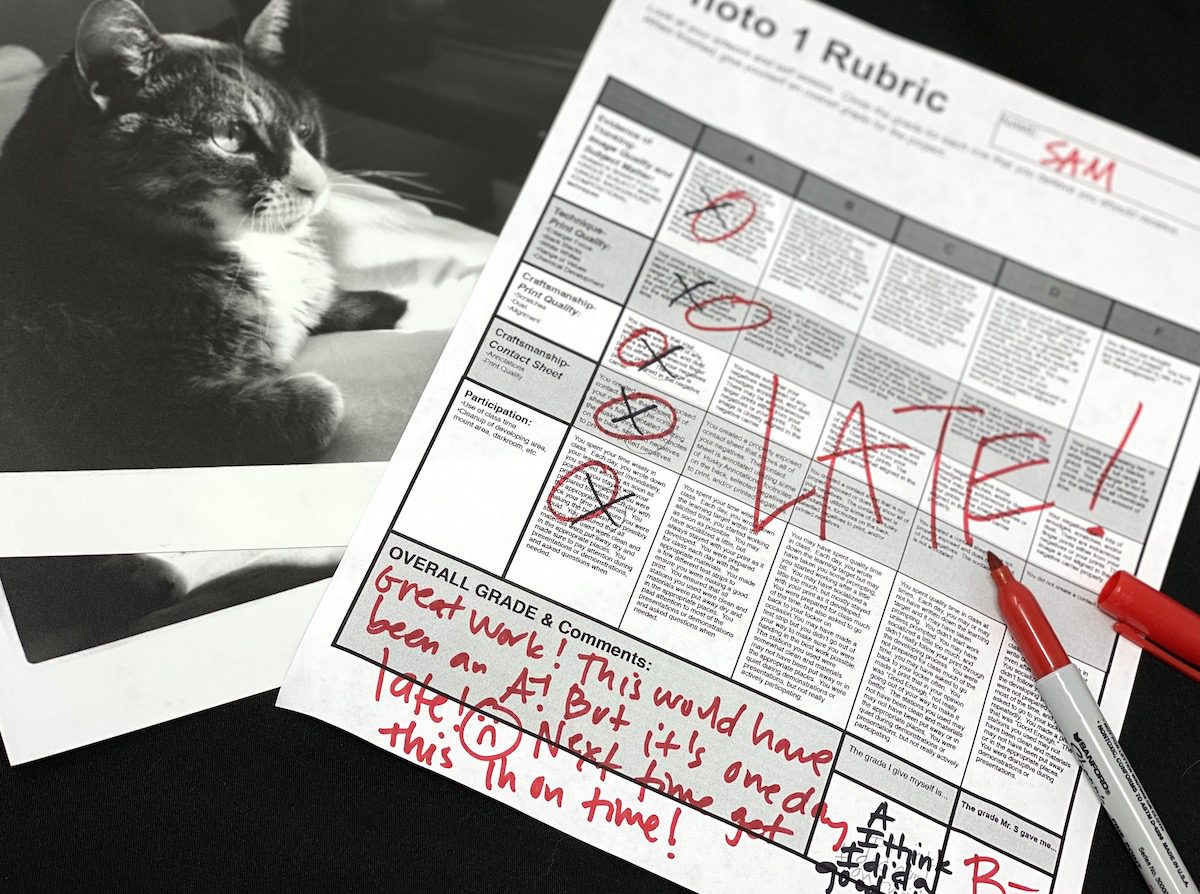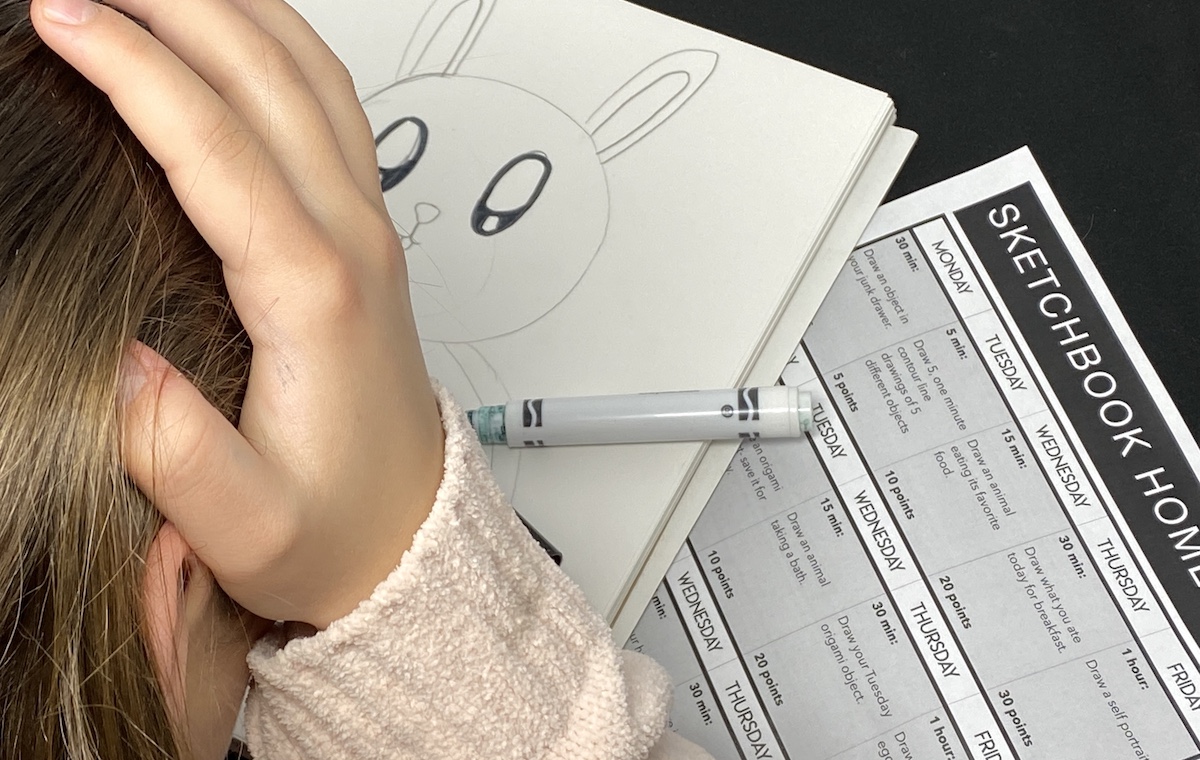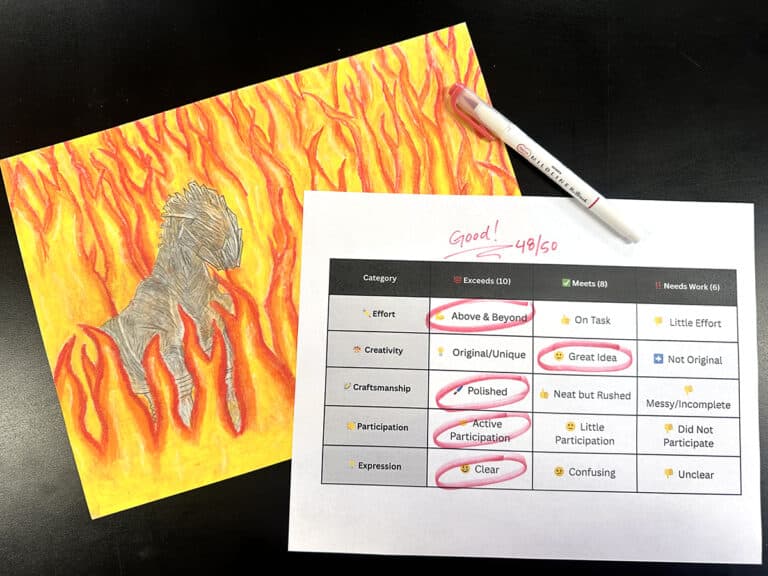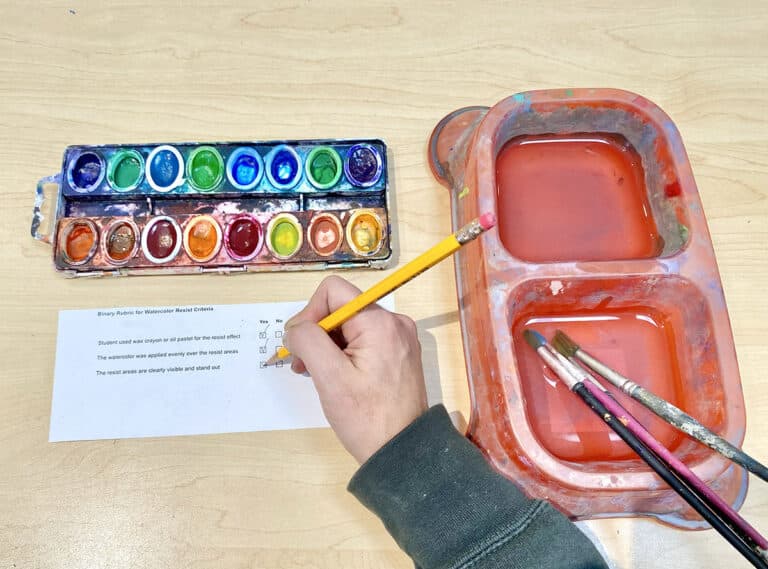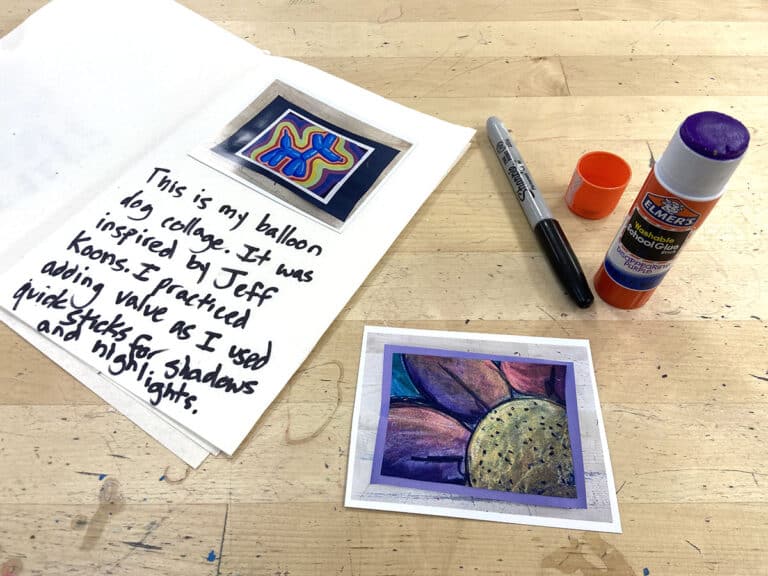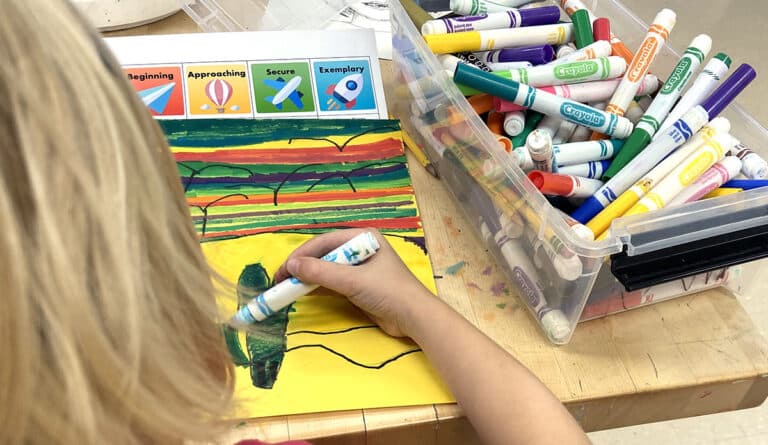Have you read Marie Kondo’s book, The Life-Changing Magic of Tidying Up: The Japanese Art of Decluttering and Organizing? The idea is to get rid of anything that does not “spark joy” in your life. This includes your teaching practices! First, reflect on practices in which the cons outweigh the benefits for your students. Then, figure out the best ways to shift your teaching to free up time and focus on what really matters.
When considering how to lighten your art teacher soul, start by giving up these top three grading practices.
1. Stop giving homework.
Homework is the backbone of any traditional teaching practice. Whether you assign weekly sketchbook assignments or expect students to complete six thumbnail sketches before coming to class, homework is part of school expectations. But why do we give homework at all?
I give homework because:
- I feel pressure to do what everyone else is doing.
- If I don’t, students won’t practice their skills.
- It is worth a percentage in my grade book.
- Students need to prove they are working on art outside of class.
- Art class is just as important as core subjects.
- I have something to prove to the administration and parents.
Listen to Taking a New Look at Assessment (Ep. 120) for more!
Sure, we think of homework as a way for students to safely practice what they are learning in class. Teachers use homework as a tool to check for understanding and know what to review or reteach.
What happens when you stop giving homework?
- Students use at-home time to prepare for class time.
- Students take ownership of their work and time-management.
- Students learn better work/life balance through prioritization.
How?
First, change the expectations in your art room. Instead of homework being an additional supplement to your curriculum, let students identify what they need to prepare to have productive studio class time.
For example, let’s say a student needs to watch a tutorial on making a contact print in the darkroom. By deciding to watch this quick video at home, they will be the first ones in the darkroom the next day. Maybe the student forgot to watch the video. They can still take class time to do this and step into the darkroom when ready. While forgetting their “homework” might push them out further, students now have learned that to use the tools, they have to be prepared. You’re now establishing life skills for students to learn on their own without being punitive.
Finally, teach students a healthy life balance by lightening their afterschool workload. Maybe other teachers are piling on the homework. Don’t make your class the reason they are up until two in the morning with stress. Let kids connect with their families, participate in a sport, or read a good book.
2. Stop penalizing for missed deadlines.
I take points away for missed deadlines because:
- I don’t want to grade late assignments.
- I want to teach students big life lessons.
- It is an expectation from my school.
- I feel angry when students don’t respect my expectations.
How?
Ask yourself, why are my students missing deadlines in the first place? One reason could be is that your expectations are too high for the timeframe you provided. Setting a deadline students cannot make based on their abilities sets students up for failure. You can’t control what happens at home, so don’t set deadlines expecting consistent work in and out of class time. A good rule of thumb is that for every hour of work you put in to create, expect it to take three hours for a student to complete that same task.
Read What Is It like to Teach Without Grades? for more!
Why?
Another reason might be your students are “just not that into” your lesson. They procrastinated because the challenge overwhelmed them. They struggled to come up with ideas. Or maybe the subject matter just doesn’t jive. Whatever the reason, there are ways to support students in these situations. Be responsive to their needs instead of penalizing them later. Taking points away from students in the final product does not teach them how to make productive progress along the way. By penalizing their artwork for being late, you are telling students the work they did put forth is, in fact, worth less.
What happens when you stop penalizing students for missing deadlines?
- Students learn to take responsibility for their process.
- Students learn how to manage their time from start to finish.
- Students feel valued for the work they put forth.
Instead, incorporate time management strategies to help students manage their own needs. Add choice into your lesson, so students have the flexibility to create from subject matter that piques their interest. Help students generate ideas as well as curate them so they can begin on time. Create specific checkpoints throughout your timeline to quickly identify struggling students and intervene at the right time. Remind straggling students you will be moving forward in class. Give some wiggle room for when students submit work.
Sometimes students don’t submit work for fear of failure. Encourage students to submit work on time regardless if they feel complete. Provide opportunities to resubmit work if students feel unfinished, rushed, or simply not happy with their vision. With the feedback you provide, students can always improve their skills. Replace a grade when students take the time to rework their art. Teach students that education is a process, not a final product. When students are rewarded for their engagement, they will feel less pressure to submit perfect work and meet deadlines.
3. Stop giving grades.
I give grades because:
- My school expects me to do so.
- That’s how students and parents understand feedback.
- That’s what I was taught to do.
- Other forms of feedback take too long.
Read Finding the Right Dose of Assessment for Your Art Room for more!
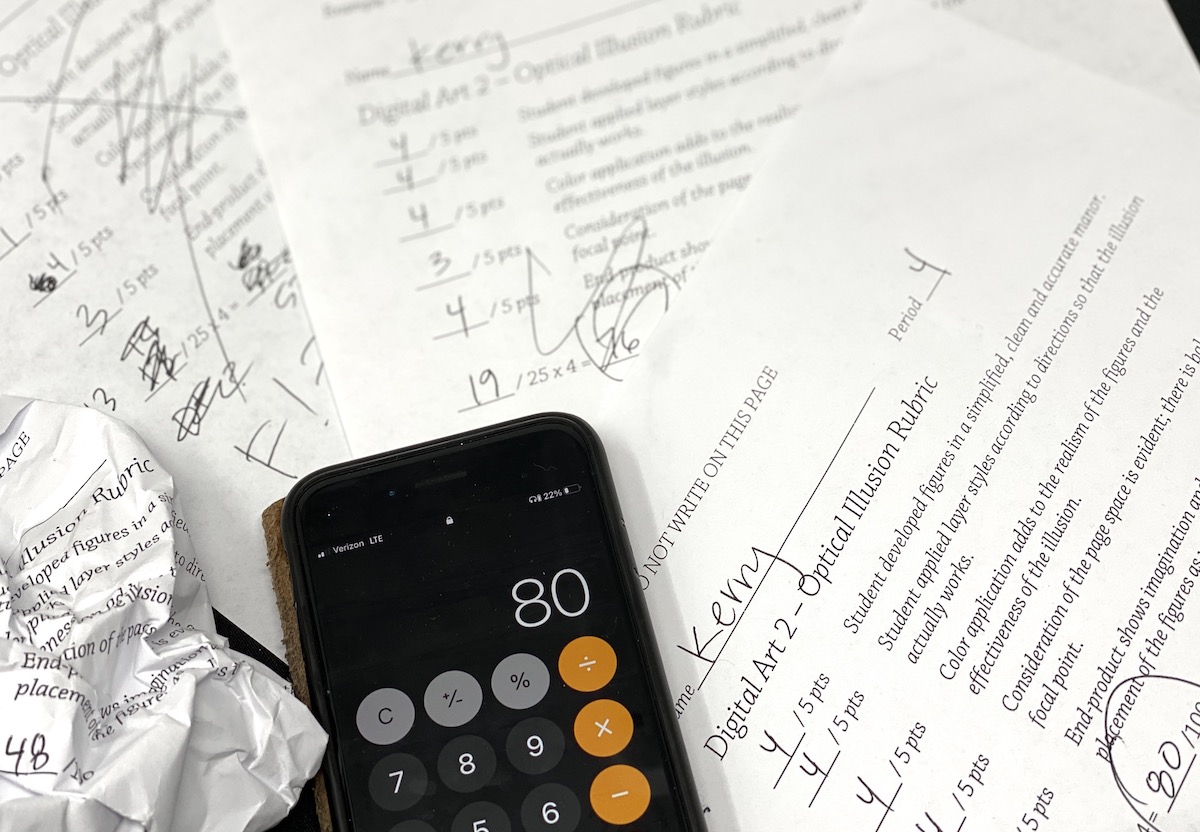
We all know it’s easier said than done. Your school, your parents, and even your students expect letter grades posted in the grade book. It’s what we all know. Instead of focusing on grades, put your effort toward assessment. Assessing students is more than putting a letter grade to an assignment. Assessment is a means of providing feedback so students can further their learning.
What happens when you stop grading and start assessing?
- Students take ownership of their learning.
- The pressure is taken off; students feel empowered to take risks.
- Feedback becomes a valuable part of the process.
How?
If there’s one place to get rid of grades, start with assessing the process. Process is a great place to focus on formative assessment, providing lots of feedback to help students succeed. No need to toss a letter label on it. If you must assign a letter or percentage grade, save it for your summative assessment. Students can safely practice formative skills and then apply those skills to create artwork. Provide thorough rubrics, so students know exactly what you are assessing.
Let go of some of those old practices that have been weighing you down. Look at how you teach and ask yourself why you do these things. Maybe it’s your school or district mandates, maybe it’s the only way you’ve taught, or maybe you’re not really sure why. Take some time to reflect on the benefits and downsides. If what you are doing is more work with little student benefit, then it’s time to ditch these methods for something new.
What grading practice do you want to give up?
What is your assessment philosophy?
Magazine articles and podcasts are opinions of professional education contributors and do not necessarily represent the position of the Art of Education University (AOEU) or its academic offerings. Contributors use terms in the way they are most often talked about in the scope of their educational experiences.

